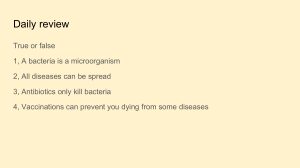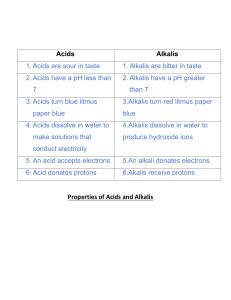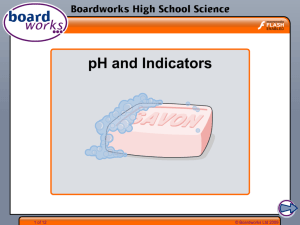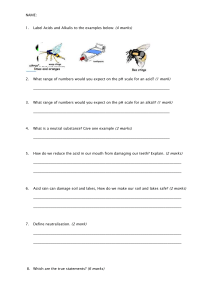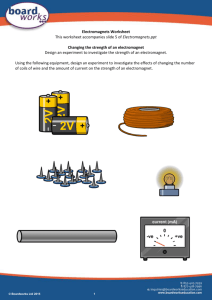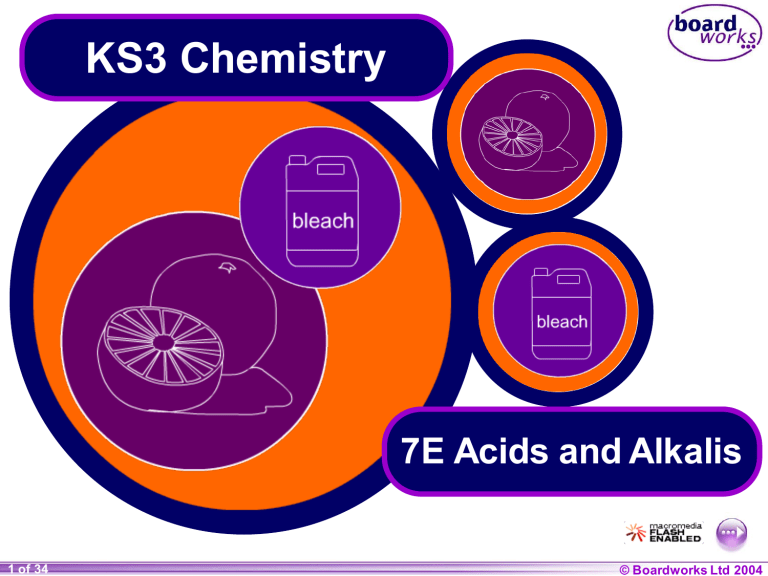
KS3 Chemistry 7E Acids and Alkalis 20 1 of 34 © Boardworks Ltd 2004 Write the WALT, date and keywords and begin the ‘Starter’! WALT: understand about acids and alkalis STARTER (5mins): With your partner discuss: What is an acid? to add text Can you nameClick any acids? What is an alkali? 1 of 34 20 2 Keywords: Acid Alkalis Corrosive Dilute Concentrate d © Boardworks Ltd 2004 What is an acid? Acids are a group of chemicals. What do you know about acids? Are all acids dangerous? 1 of 34 20 3 © Boardworks Ltd 2004 What is an acid? Acids are a group of chemicals. Which of these items contains an acid? everyday acids laboratory acids Can you think of other examples of acids? 1 of 34 20 4 © Boardworks Ltd 2004 What is a weak acid? Acids are found in household items such as food, drink and beauty/skincare products. It is safe to handle these acids and even taste them, if they are for eating! These acids are known weak acids. 1 of 34 20 5 © Boardworks Ltd 2004 • Vinegar are made from: Acetic Acid / Ethanoic Acid • Citrus fruits like orange, lemon and limes contains Citric Acid • Vitamin C – Ascorbic Acid • Natural acids, e.g. methanoic acids can be a nuisance; it helps make bee and ant stings painful 1 of 34 20 6 © Boardworks Ltd 2004 What is a strong acid? Some acids, like those found in the laboratory or a car battery, are very dangerous (too dangerous to taste or touch). These acids are said to be corrosive as they can damage other materials by wearing them away! They are strong acids. Why must strong acids always be handled very carefully? 1 of 34 20 7 © Boardworks Ltd 2004 Taste of Acid • Fizzy drinks are carbonated drinks (soft drinks) • Many of them contains acid so that the drinks taste “tangy” • Acid usually taste sour, sharp or tangy 1 of 34 20 8 © Boardworks Ltd 2004 Pickling Food • Some food can be preserved by pickling them: soaking them in vinegar • Great way to preserve food as most bacteria can’t survive in such acidic conditions • It also makes the pickled food more flavourful 1 of 34 20 9 © Boardworks Ltd 2004 The Acid Bath Murderer Concentrated acids can completely dissolve skin and bones. In the 1940s, an Englishman called John Haigh murdered six people, and disposed of each of the bodies by dissolving them in sulfuric acid for two days. Without the bodies as evidence Haigh thought he would get away with the crimes, but a pathologist found human fat, pieces of bone, gall stones and false teeth, which had resisted the acid. John Haigh was found guilty of the murders and sentenced to death by hanging in 1949. 1 ofof20 10 34 © Boardworks Ltd 2004 Acid summary • Usually Taste Sour, sharp, tangy • Strong acid are Corrosive • pH 0-6 • Examples: Lemon juice, Vitamin C (Ascorbic acid), Vinegar • Lab Chemical: Hydrochloric Acid, Sulphuric Acid • Used to preserve and add flavour to food; make fertilisers, detergents, dyes, medicines, insecticides, paints, 1 ofof20 11 34 batteries © Boardworks Ltd 2004 What is an alkali? Alkalis are another group of chemicals, the opposite of acids. Which of these items contains an alkali? everyday alkalis laboratory alkalis Can you think of other examples of alkalis? 1 ofof20 12 34 © Boardworks Ltd 2004 What is an alkali? Alkalis are substances that are chemically the opposite of acids. Weak alkalis are found in soaps and other cleaning materials. They are also used in antacids to treat indigestion. It is safe to handle these alkalis, which often feel soapy. These alkalis are weak alkalis. 1 ofof20 13 34 © Boardworks Ltd 2004 • Sodium hydroxide solution is an important alkali- to make paper, detergents and aluminium metal. 1 ofof20 14 34 © Boardworks Ltd 2004 Alkali Summary • Taste Bitter • Slippery feel • pH 8-14 • Examples: Soap, detergent, tooth paste, baking soda • Strong alkali corrosive as well • Lab Chemical: Sodium Hydroxide, Lime water (Calcium Hydroxide) • Used as cleaning agents 1 ofof20 15 34 © Boardworks Ltd 2004 What is a weak alkali? Alkalis are found in soaps and other materials used for cleaning. It is safe to handle these alkalis, which can feel soapy. These alkalis are known as weak alkalis. 1 ofof20 16 34 © Boardworks Ltd 2004 What is a strong alkali? Some alkalis, like those in the laboratory or in cleaning materials such as toilet cleaner, are too dangerous to touch. These alkalis are said to be caustic because they can burn skin and damage other materials! They are strong alkalis. Why must strong alkalis always be handled very carefully? 1 ofof20 17 34 © Boardworks Ltd 2004 What are hazard symbols? How can you tell which chemicals are safe and which are dangerous? Special symbols are used on bottles and vehicles that contain dangerous chemicals. i toxic irritant h harmful corrosive highly flammable These hazard symbols show why the chemical is dangerous. Why is it important that these symbols can be recognised by people from other countries? 1 ofof20 18 34 © Boardworks Ltd 2004 What do hazard symbols mean? 1 ofof20 19 34 © Boardworks Ltd 2004 Contents 7E Acids and Alkalis What are acids and alkalis? Hazard symbols Indicators and the pH scale Neutralization Summary activities 1 ofof20 20 34 © Boardworks Ltd 2004 What is an indicator? How can you test a liquid to find if it is an acid or an alkali? An indicator is a special chemical that changes to a different colour in an acid or an alkali. Litmus paper and litmus solution are examples of indicators. Litmus is red in acid. 1 ofof20 21 34 Litmus is blue in alkali. © Boardworks Ltd 2004 Litmus test experiment 1 ofof20 22 34 © Boardworks Ltd 2004 What is universal indicator? Litmus is used to show if a solution is acid or alkali. Litmus does not show if the acid or alkali is weak or strong. Universal indicator has a range of colours that show how weak or strong the acid or alkali is. stronger acid strong acid stronger alkali weak weak acid neutral alkali strong alkali What is the colour for a weak acid? What is the colour for a strong alkali? 1 ofof20 23 34 © Boardworks Ltd 2004 What is the pH scale? The strength of an acid or alkali is measured by the pH scale. Each universal indicator colour is given a number called the pH value. Universal indicator can tell you the pH of a solution. stronger acid stronger alkali 1 2 3 4 5 6 7 8 9 10 11 12 13 14 strong acid weak weak acid neutral alkali strong alkali What is the pH of a weak acid? What is the pH of strong alkali? 1 ofof20 24 34 © Boardworks Ltd 2004 What is the pH? 1 ofof20 25 34 © Boardworks Ltd 2004 What type of substance? Are these substances acidic or alkaline? Are they weak or strong? Substance soda water car battery acid 1 Description of acid/alkali very weak acid very strong acid soap 8 very weak alkali washing soda 10 weak alkali stomach acid 2 strong acid oven cleaner 14 very strong alkali vinegar 4 weak acid acid 1 ofof20 26 34 pH 6 1 2 3 4 5 6 7 8 9 10 11 12 13 14 alkali © Boardworks Ltd 2004 Contents 7E Acids and Alkalis What are acids and alkalis? Hazard symbols Indicators and the pH scale Neutralization Summary activities 1 ofof20 27 34 © Boardworks Ltd 2004 Mixing an acid and an alkali What happens when an acid and an alkali are mixed? ? Mixing an acid and an alkali causes a chemical change. This chemical change is called a chemical reaction. How do you know this chemical reaction has taken place? 1 ofof20 28 34 © Boardworks Ltd 2004 What is neutralization? The chemical reaction between an acid and an alkali is called neutralization. acid alkali a salt water What happens to the pH value of the reaction mixture during neutralization? The pH value of the reaction mixture becomes closer to 7. 1 ofof20 29 34 © Boardworks Ltd 2004 What is neutralization? The chemical reaction between an an acid and an alkali can be written as: acid alkali a salt water What are the two new substances produced by a neutralization reaction? 1 ofof20 30 34 © Boardworks Ltd 2004 Neutralization and indigestion 1 ofof20 31 34 © Boardworks Ltd 2004 Neutralizing stings 1 ofof20 32 34 A bee sting is acidic. A wasp sting is alkaline. Why can bicarbonate of soda (pH 9) be used to treat a bee sting? Why can vinegar (pH 3) be used to treat a wasp sting? © Boardworks Ltd 2004 Neutralizing soil Soils in different places can be acidic, alkaline or neutral. Many plants do not grow well in acidic soil. Why do farmers test soil to check the pH? Farmers often add an alkali to acidic soil to make their plants grow better. How does the alkali help to treat the acidic soil? 1 ofof20 33 34 © Boardworks Ltd 2004 Neutralizing acid rain Gases emitted by cars, power stations and factories mix with rainwater in the atmosphere. This rainwater has a pH <5.5. Why is it called acid rain? Acid rain can have a harmful effect on the environment killing trees, polluting lakes and damaging buildings. How can the effects of acid rain be prevented? 1 ofof20 34 34 © Boardworks Ltd 2004 Contents 7E Acids and Alkalis What are acids and alkalis? Hazard symbols Indicators and the pH scale Neutralization Summary activities 1 ofof20 35 34 © Boardworks Ltd 2004 Glossary ⚫ acid – A chemical that has a pH less than 7. ⚫ alkali – A chemical that has a pH greater than 7 and dissolves in water. ⚫ indicator – A special chemical that changes into different colours in acid and alkali solutions. ⚫ neutral – A chemical with a pH of 7 that is not an acid or an alkali. ⚫ neutralization – The chemical reaction between an acid and an alkali. ⚫ pH scale – The range of values that shows how strong or weak an acid or alkali is. ⚫ universal indicator – The indicator that shows the pH value of a chemical. 1 ofof20 36 34 © Boardworks Ltd 2004 Anagrams 1 ofof20 37 34 © Boardworks Ltd 2004 Word search 1 ofof20 38 34 © Boardworks Ltd 2004 Facts about acids ⚫ Weak acids, like lemon juice and vinegar, taste sour. ⚫ Strong acids are corrosive and can “eat away” at metal, stone and flesh! ⚫ Acids turns blue litmus paper red. ⚫ Acids have a pH of less than 7. ⚫ Acids can be neutralized with alkalis. 1 ofof20 39 34 © Boardworks Ltd 2004 Facts about alkalis ⚫ Alkalis feel soapy and are used in household cleaning materials. ⚫ Strong alkalis are caustic. ⚫ Alkalis turn red litmus paper blue. ⚫ Alkalis have a pH of more than 7. ⚫ Alkalis can be neutralized with acids. 1 ofof20 40 34 © Boardworks Ltd 2004 Multiple-choice quiz 1 ofof20 41 34 © Boardworks Ltd 2004
